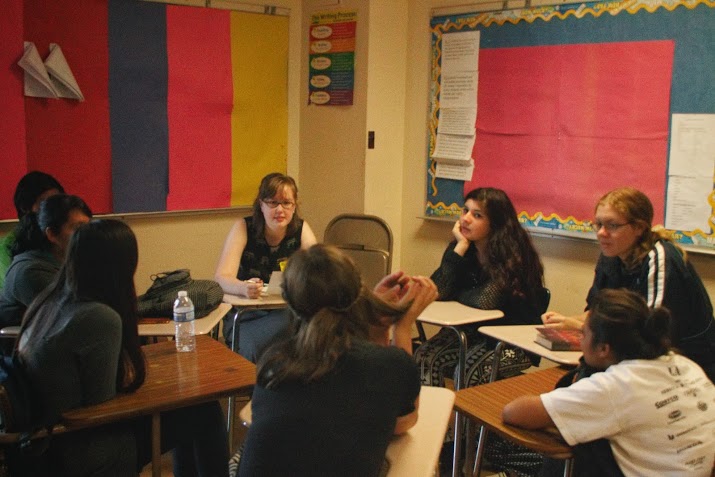
Jen Nowell, a student in Annenberg’s community journalism class, discusses with Foshay high schoolers how to write stories about education. | Keny Contreras
A group of student editors and web designers at the journalism club of Foshay Learning Center were plotting something big: Publishing the second issue of their school newspaper. The Foshay Chronicle will be printed in the beginning of the new year.
As the semester drew to a close in December, members of the journalism club were busy finalizing stories written by middle and high school students in journalism classes. Their “beats” ranged from sports to education and from food to technology – even the homecoming dance.
“Now it’s becoming real,” said Casey Cortes, a senior and editor at the journalism club. “I can’t wait for the students of Foshay Learning Center to read their school’s paper.”
Foshay Learning Center is an LAUSD school in South L.A. with students from kindergarten through 12th grade. Soon, its students and faculty will have a copy of a five-page newspaper in hand, a manifest of the students’ not-often-heard voices.
Giving students the chance to read about themselves increases their school pride, said Cortes.
Antonio Yat Jr., a fellow student and the newspaper’s mastermind, said the “trials and tribulations” of creating the publication have been worth it.
Making our voices heard
The fact that his school didn’t have a newspaper had been nagging at Yat, a junior, for some time. After talking with fellow students – his close friends for nearly a decade – Yat realized a school paper could help students launch journalism careers while also keeping the campus informed.
After graduation, he plans to study journalism or business, then go on to work in film, broadcast journalism or perhaps detective work.
Patrick O’Donnell, an English and journalism teacher, was called on to sponsor the club.
Although there was no journalism class at the time, “the founders were highly motivated,” said O’Donnell.
The earliest club was a tight-knit five-member group with Yat as editor overseeing a co-editor and online manager, photographer, head writer and artist.
Yat and his friends quickly realized that simply being enthusiastic was far from enough. They needed stories, and lots of them, in order to get started.
“The hardest part of starting a school’s newspaper is trying to get people interested,” said Cortes, who joined later.
To address that setback, the journalism club launched a “Creative Contest” that aimed to explore the nature of creativity while getting students involved.
They started with a straightforward initiative. Students were encouraged to submit photos, poems, short stories or artwork, and the club would publish three from each category in the upcoming newspaper.
While the journalism club was scrambling for stories, a new journalism class came to the rescue, offering stories that had been written as homework assignments.
The first edition of The Foshay Chronicle was printed in the fall of 2013.
A collaboration
The journalism class also benefited from a collaboration with the Annenberg School for Communication and Journalism at the University of Southern California.
For the first half of the semester, USC students from the community journalism class worked as editors with the high school students. The USC students then decided on a beat each would cover with their high schoolers, drafted a syllabus and planned how to work with high school students in a newsroom-like environment under the instruction of adjunct professor Ethan Lindsey, an editor at “Marketplace,” the well-known radio program. (The author of this article is one of the eight students involved with the community journalism class.)
At the same time, the 30-student journalism class at Foshay Learning Center learned the basics of newspaper design, production, history, and ethics.
At the end of the semester, student mentors edited the stories written by the class before handing them to the journalism club for final publication.
So far, the simple idea for a journalism club has flourished into a collection of 20 stories.
O’Donnell plans for the club to publish a newspaper every month, and regularly update the website. He credits the USC mentors for helping to make it happen.
First shot at journalism
Byron Padilla wrote his first article about Apple’s new iPad Air. The senior, a student in Foshay’s Tech Academy, calls himself an Apple fanatic and computer geek. He finds himself playing Call of Duty or fiddling with computers in his spare time, and has animation skills with Photoshop, Illustrator and Dreamweaver programs.
With no prior experience in journalism, Padilla said finding people to interview was “nerve-wracking.”
“I went up to them and said I wanted to interview you,” he recalled. “They gave you that look, ‘Why you?’ Then I explained to them I’m a senior here. I’m doing this [story]. Would you like to be interviewed? They were cool. I just asked questions. Everything went well.”
Cortes was similarly new to journalism before becoming a leader in the club. She seized the opportunity as a way to “learn how to get out of my comfort zone.”
Interviews gave her a chance to talk with interesting people, like a Barnes and Nobles employee who was writing a novel.
“I was in awe because by only asking him a few questions I learned so much more from this one stranger,” she said.
English teacher O’Donnell, a first-time journalism instructor, also discovered the far-reaching positive influence of journalism.
The previous summer he had participated in a training program at USC arranged by Student Voice Project, an organization dedicated to addressing inequalities in journalism education.
“It made me excited about the possibilities of journalism to increase student engagement and utilize real world applications of the skills that we want students to develop,” he said. He is planning incorporate journalism in all of his English classes next semester.
The collaboration between Foshay’s journalism class and USC journalism school has already borne fruit: a ready-to-publish newspaper.
“It has the potential to be a strong voice and resource,” said O’Donnell. “I am really excited about our momentum.”















Speak Your Mind